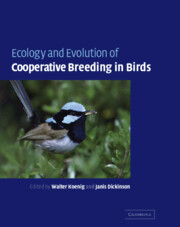Book contents
- Frontmatter
- Contents
- List of contributors
- Introduction
- 1 Evolutionary origins
- 2 Delayed dispersal
- 3 Fitness consequences of helping
- 4 Parental care, load-lightening, and costs
- 5 Mating systems and sexual conflict
- 6 Sex-ratio manipulation
- 7 Physiological ecology
- 8 Endocrinology
- 9 Incest and incest avoidance
- 10 Reproductive skew
- 11 Joint laying systems
- 12 Conservation biology
- 13 Mammals: comparisons and contrasts
- 14 Summary
- Names of bird and mammal species mentioned in the text
- References
- Taxonomic index
- Subject index
9 - Incest and incest avoidance
Published online by Cambridge University Press: 02 December 2009
- Frontmatter
- Contents
- List of contributors
- Introduction
- 1 Evolutionary origins
- 2 Delayed dispersal
- 3 Fitness consequences of helping
- 4 Parental care, load-lightening, and costs
- 5 Mating systems and sexual conflict
- 6 Sex-ratio manipulation
- 7 Physiological ecology
- 8 Endocrinology
- 9 Incest and incest avoidance
- 10 Reproductive skew
- 11 Joint laying systems
- 12 Conservation biology
- 13 Mammals: comparisons and contrasts
- 14 Summary
- Names of bird and mammal species mentioned in the text
- References
- Taxonomic index
- Subject index
Summary
Cooperative breeders live in groups that usually, although not always, consist of close relatives. Following Hamilton's (1964) rule, high relatedness serves to increase fitness by facilitating kin selection and the evolution of cooperative behaviors such as are frequently observed within societies of cooperative breeders. On the other hand, if high relatedness extends to opposite-sex breeders, there is the risk of inbreeding and its attendant genetic problems leading to significantly lowered fitness. How cooperative breeders resolve these conflicting selective pressures has long been recognized as a dilemma and has served as an important focus of research in this field.
Determining how societies resolve the potential problem of inbreeding has turned out to be unexpectedly difficult. First, there are semantic problems. Inbreeding is both a relative and a hierarchical phenomenon, and it is likely that inbreeding may be avoided at some levels but not others (Dobson et al. 1997). At one extreme, mates may share no known relatives going back several generations and can be considered “outbred” in that they share fewer genes identical by descent than two random individuals in the population. At the other extreme, mates may be close relatives such as siblings or a parent and offspring. Unless all genetic variability in the population has been previously lost, such individuals will be genetically more similar to each other than two randomly chosen individuals in the population, and thus their offspring will have an elevated proportion of homozygous loci identical by descent.
- Type
- Chapter
- Information
- Ecology and Evolution of Cooperative Breeding in Birds , pp. 142 - 156Publisher: Cambridge University PressPrint publication year: 2004
- 67
- Cited by



